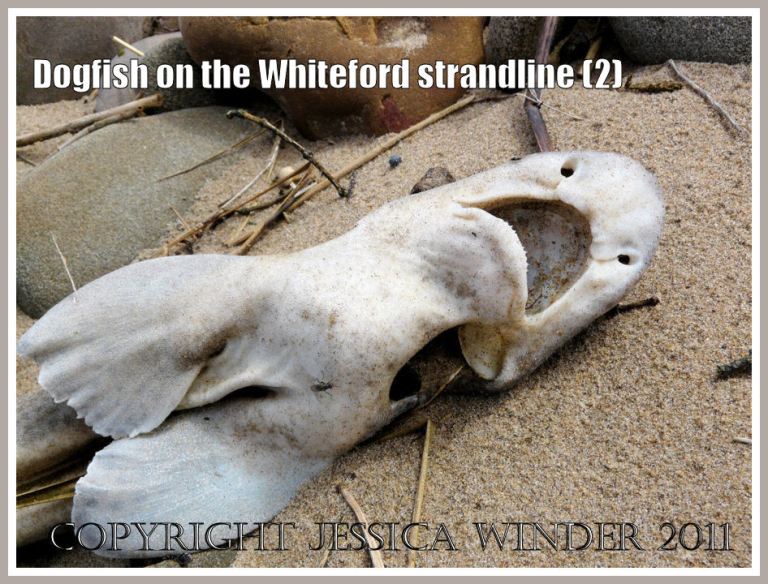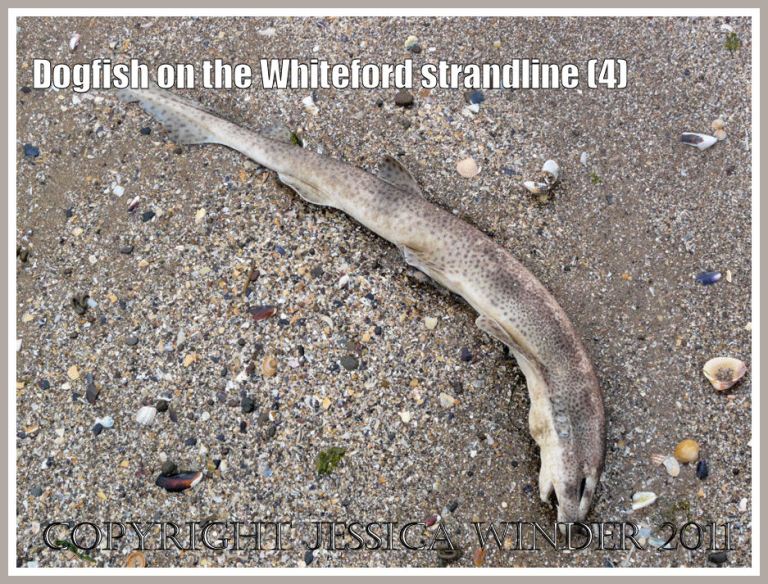The Lesser Spotted Dogfish or Rough Hound, Scyliorhinus caniculus (Linnaeus), found on the strandline at Whiteford Sands, Gower. The photograph above illustrates the most important feature for distinguishing this species from the Large Spotted Dogfish or Nurse Hound, Scyliorhinus stellaris (Linnaeus).
In the Lesser Spotted Dogfish as shown above, the nasal flaps, the skin that extends from the nostrils down to the upper lip, describe a smooth continuous curved groove down to and along the lip line. In the larger Nurse Hound, the nasal flaps and nostril grooves turn away from the mouth and the outline is approximately W-shaped.
The Lesser Spotted Dogfish is cartilaginous rather than bony and very shark-like because it is related to that group of fish. You can see the small sharp teeth on the lower jaw; in fact, these are denticles in the skin rather than ‘proper’ teeth embedded in the jaw bone. The rough skin covering the whole animal contains thousands of similar but microscopically small versions of the teeth in the mouth.
The Lesser Spotted Dogfish grows upto 75 cm long compared with1.5 m long in the Nurse Hound. It is common and lives on sand or mud in shallow water. (The Nurse Hound likes rocky ground in shallow water). It is considered to be quite tasty (when fresh) and is the fish that used to be called ‘rock salmon’ and sold in fish and chip shops.
Finally, a view of the Lesser Spotted Dogfish showing the darker colouring of the upper and side surfaces with the characteristic spot markings.
For more information on the Nurse Hound see the information page on this blog.
Revision of a post first published 12 May 2009
COPYRIGHT JESSICA WINDER 2011
All Rights Reserved





I find dead dog fish way too often on Gower’s beaches. Always a sad sight.
LikeLike
I wonder why that is? Is it possible that fishermen catch them, then discard them? I’m not certain whether ‘rock salmon’ is as popular as it once was. Maybe if dogfish are caught by accident, surplus to requirements, they are tossed overboard. What do you reckon?
LikeLike
Just got back from Trearrdur Bay in Anglesey. On Bank Holiday Monday -24th May 2009- found 7 dead dogfish in (otherwise!) perfect condition washed ashore in the main bay.
Later that afternoon we watched as a dogfish seemed to be beaching itself as the tide went out along a narrow gully on a rocky shore. We tried to turn it back but it persisted in trying to wriggle through a mass of kelp beyongd the waters edge. Why would this be?
LikeLike
Hi,
Thank you for getting in touch. I am not certain what the answer is to your question about dogfish deaths and strandings. As I mentioned in my own posting, one suggestion could be something to do with fishing practices – some kinds of trawling are illegal in UK waters because of the way they lead to the incidental deaths of all sorts of bottom living marine animals but these techniques may still be used by fishermen from other countries in British waters. Perhaps, if you were to contact DEFRA, they might be able to tell you what the answer might be. There could be many explanations.
The Marine Life Information Network (marLIN) based at the Marine Biological Association in Plymouth is a mine of information and might be able to help you further. You can click here to get directly to the marLIN page on dogfish – http://www.marlin.ac.uk/speciesinformation.php?speciesID=4319 – or contact them with your question.
LikeLike
Here to ask if anyone has a definitive answer as to why dogfish are washed up dead on the North Wales coastline, is it down to illegal fishing practices from what ive heard Spain in particular and if so why are they able to fish off the coast of Anglesey or anyone from any other foreign country. Is this the reason or is there a problem with some parasitic illness in the native population I would love to know. By the way this is not being a europhobe.
LikeLike
Hi, Posh Bob. I don’t know the answers to your questions but I do know where you might find them. The Centre for Environment, Fisheries, and Aquaculture Science – CEFAS – at http://www.cefas.co.uk/ should be able to help you.
LikeLike
Jessica – How strange; I was Googling to see if I could identify a headless fish we found at low tide near Worthing this weekend and an images search brought me to this post! And looking at your pictures I think it may have been a Lesser Spotted Dogfish. I’ll post the picture when I cover that walk in a couple of weeks’ time and link to your post. Thanks for the unexpected help! Nic
LikeLike
Pleased to hear the information was useful, Nic.
LikeLike
Many thanks Jessica for showing the nasal furrows id feature for the two similar types of dogfish; much clearer than on the Shark Trust’s id sheet. I too am alarmed when I see such lovely creatures on our Cardigan Bay coast, usually with large holes just behind the head. I surmised maybe that’s where they would be gaffed to haul out the net and chuck back in; no-one would attempt to pick it up given the razor sharp skin! Try your macro on its skin when you find another. Apologies if you have already posted.
LikeLike
Thank you, Elizabeth. I am pleased that you found the photographs helpful for identification. I will try my macro on the dogfish skin next time. I might even try out my new USB microscope on the skin texture when I get the opportunity.
LikeLike